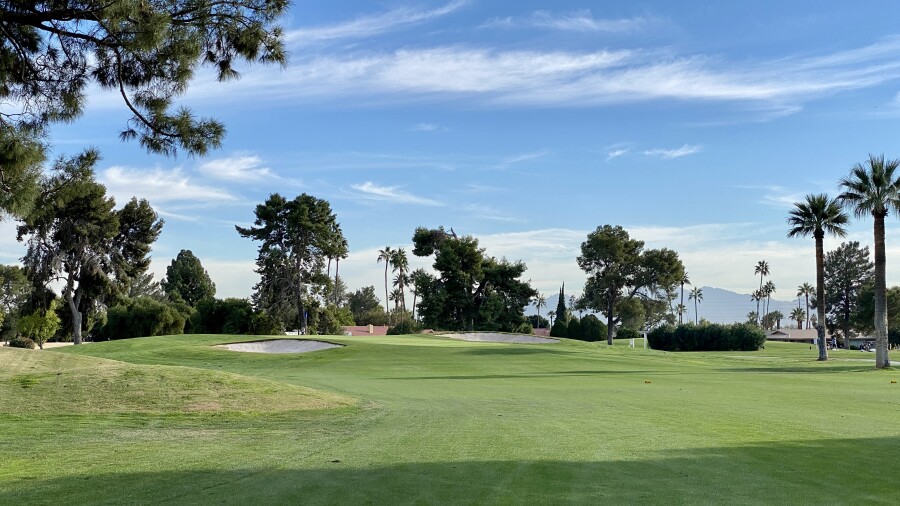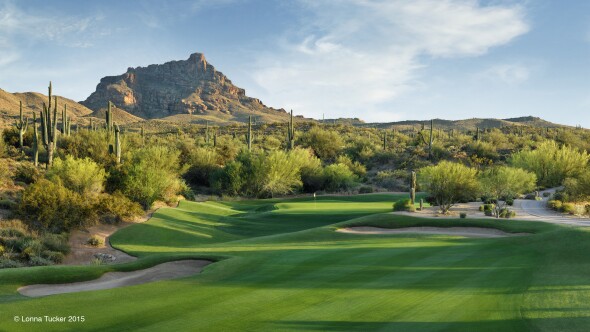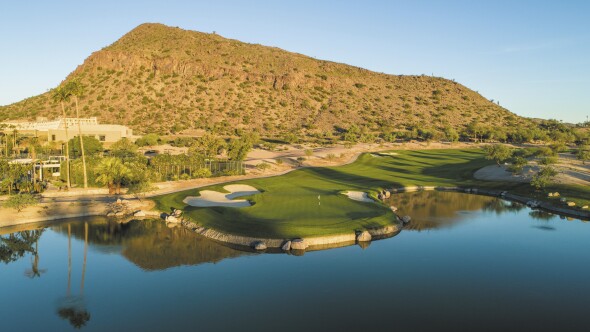Desert golf is polarizing.
Ahead of my first-ever trip to Arizona (a few steps over the border during a trip to the Hoover Dam many years ago notwithstanding), I polled a few people I know on it.
Just as many seemed to love it as were nonplussed by it. Some were even downright negative. Something about the potential for lost golf balls and ripped golf shorts on cactus needles. The sense I got was that desert golf could be as confining as golf here in subtropical Florida, if not more so.
I made sure to buy a fresh dozen balls before leaving.
Now that I’m back, I’m ready to rule on desert golf.
If you’ve heard similar lost-ball horror stories about desert golf and have been sitting on the fence in some colder region, apprehensive about scheduling a trip, I’ve got one word for you.
Go.
Based on a sample size of 10 courses – seven played, three others toured – I’m a fan. I can’t wait to go back and try some more of it, in fact.
I like to think I’m good at doing my research and going to an unfamiliar place decently informed, but it took actually going to the Phoenix/Scottsdale area to appreciate the stunning diversity of golf courses on offer (no wonder it's #7 on our list of the World Top 100 Golf Destinations). The style of golf out that way is not as monolithic as some would have you believe. It is a broad spectrum; you may be shocked at the differences in how courses look and play, even those in relatively close proximity.
If you’re particularly wild off the tee and want to limit your potential for interaction with the local flora and fauna, I don’t blame you. There are plenty of Phoenix/Scottsdale courses for you. The least “deserty” courses I played in the area were the three at The Wigwam, a historic resort in the quiet community of Litchfield Park, about 35 miles west of PHX.
Founded in the 1920s by Goodyear as a retreat for the tire company’s employees, it was conceived as an oasis. Tall, skinny palms dominate much of the landscape, rather than cacti, though there are a few off-play areas where some turf has been swapped out for desert reintroduction.
The Gold and Blue courses are the centerpiece for Wigwam guests, proceeding out from the main clubhouse and back in non-returning nines. The Gold Course is the big beast: 7,300 yards from the tips with two par 5s stretching to 654 and 660 yards, respectively. Elevated greens with some inventive shapes and considerable undulations give the course a muscular, stately feel, as do the bunkers, renovated by Tom Lehman in 2015. Though a thousand yards shorter, the Blue will sneak up on you, with some domed putting surfaces and six par threes.
The Red is the favorite course of The Wigwam’s vibrant membership, who like that it’s not terribly difficult. It occupies the most interesting terrain on the property: gently rolling hills and broad tilts that make for subtle challenges coming into the greens. An oak-heavy tree plan gives it a different feel; whereas the Blue and Gold remind many of the Palm Springs area, I got an unexpected Central-Florida vibe from the Red. The course would fit right in at, say, Innisbrook Resort. Safe to say The Wigwam provides “golf in the desert,” as opposed to “desert golf.”
If you want bona fide “desert golf,” though, you’ll never find more examples than in the Valley of the Sun, which encompasses the Phoenix/Scottsdale metro area. My first course of the trip was the Saguaro Course at We-Ko-Pa Golf Club, a Bill Coore/Ben Crenshaw gem that meanders through sloping desert so gracefully that it creates harmony between the manmade and the natural. Building architect Frank Lloyd Wright, whose Taliesin West estate is nearby, was known for designing homes that were not just in a particular landscape, but were of that landscape. We-Ko-Pa Saguaro is not a golf course in the desert, but a golf course of the desert.
Despite the constant integration of the natural environment with the playing field, Saguaro is forgiving, with generous fairways and a level of manicuring to the immediate natural areas that often makes finding and playing a shot from the sand and scrub possible. The fact that golfers are encouraged to walk the course adds to the sense of immersion. I can’t think of a better possible way to have been greeted by golf in the area.
Other courses I saw use the desert in different ways. At Eagle Mountain Golf Club, just six miles west of We-Ko-Pa, architect Scott Miller routed the course over more mountainous terrain, with holes meandering up and down canyons. The result: a very forgiving course, with concave features often gathering slight misses back toward the middle of fairways and some amphitheater greens. Recent renovations that reduced the bunkers from 60 to 31 help make things pleasant.
So does the scenery. With a clubhouse near the high point of the property, Eagle Mountain sets an awfully strong tone when you arrive. Both the 10th and 18th holes offer arresting views across the Valley of the Sun. Play here in the afternoon in order to take in the sunset from the clubhouse terrace.
FireRock Country Club rising

Next door to Eagle Mountain, this private club is on the upswing. Gary Panks designed the original course in 2000. Playability and maintenance concerns prompted the membership to hire area architect Andy Staples to redo the bunkers in 2019. The results are striking. The new bunkers add some much-needed strategic merit to the course. Holes that were strategically one-dimensional now ask golfers to weigh risk and reward in different ways. A clever side-effect is that engaging golfers more with the layout of the hole itself means they will be less distracted by the perils awaiting wildly wayward shots. It’s a dual win for playability.
The other courses I saw sit somewhere in the middle of the golf-in-the-desert/desert-golf spectrum. The Phoenician Resort, whose course was reduced from 27 to 18 holes and rejiggered by architect Phil Smith in 2018, splits things down the middle. The low-lying front nine meanders through homes and resort buildings with some desert accents, while the back nine heads for the hills, peaking at the 13th tee with a miles-long view of city, desert and mountains.
The Phoenician sits on the south slope of Camelback Mountain, a local landmark. On the other side is Mountain Shadows, an 18-hole par-3 course at a mid-century modern resort that local architect Forrest Richardson redesigned in 2017. Mountain Shadows is a perfect middle-ground spot for afternoon arrivals – you can play it in two and a half hours and get a wonderful introduction to the local landscape. You will also get a bit of a golf history lesson, as Richardson incorporated various old-school golf design concepts – a Biarritz green, a Redan hole, a “thumbprint” in another green – into the course.
The City of Phoenix’s municipal golf gem, Papago Golf Club, also blends parkland with desert golf. Tree-lined corridors mingle with exposed sandy areas to lend a great texture to the experience of playing one of the country’s best local haunts.
With dozens of golf courses spread across the Valley of the Sun, you can take on as much or as little of the natural landscape as you want when you go play golf. My recommendation: get a glimpse of the full spectrum to find out what agrees most with your game.

































I have played both WE KO PA Courses, Eagle Mtn. and Sun Ridge Canyon in Fountain Hills. The 4 courses are very different and challenging. I just wish they were more affordable to local residents.
Dude, you wasted your time and text blathering about Wigwam, and no mention of Boulders (2 courses) and Troon (2 courses) both with the most amazing scenery in all of Phoenix/Scottsdale, Grayhawk (2 courses), and TPC (2 courses)-famous Tournament course with Stadium Hole, and next door Champions Course. And by the way, the Cholla course at WeKoPa is as outstanding as the Saguaro The Casino Hotel there offers stay and play specials that can't be beat.
Why write about a private course visitors can't access ? Suggest you return and write a real article about real Valley of the Sun golf.
Tim, I have played all of the courses you mentioned and you are right. There is nothing like like desert golf. Next time you go try Rancho Manana Golf Resort a little bit north of Scottsdale in Cave Creek.
And for another great desert golf destination try Mesquite, NV that includes a wild up & down ride of golf at Wolf Creek.
Eagle Mountain and Papago don't hold a candle to AkChin Southern Dunes, tae a drive out to Maricopa and play a real course !!!!